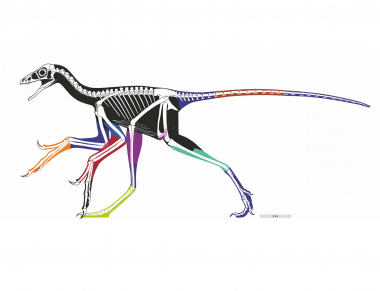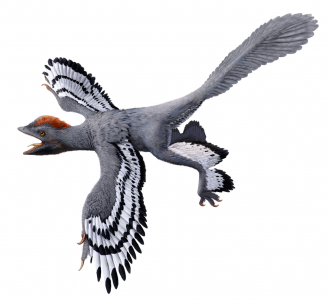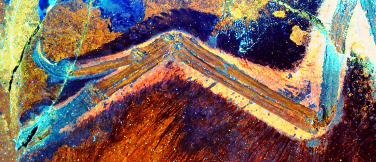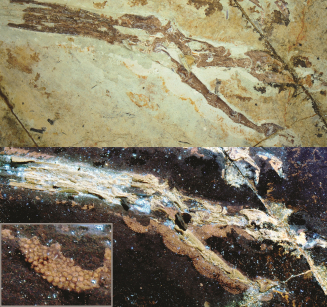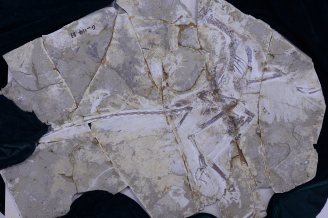Media
Major breakthrough in knowledge of dinosaur appearance
HKU palaeontologist reconstructs feathered dinosaurs in the flesh with new technology
01 Mar 2017
Dr Pittman and the laser-stimulated fluorescence device used for scanning the soft tissues of Anchiornis. (Background photo is a life reconstruction of bird-like feathered dinosaur Anchiornis)
Until now it has been hard to get an accurate idea of the shape of a dinosaur from its fossilised remains, as only their bones are usually preserved. Using a new technique, Dr Michael Pittman from the Department of Earth Sciences, the University of Hong Kong and his collaborators reconstructed the first highly detailed body outline of a feathered dinosaur based on high-definition images of its preserved soft tissues (Fig. 1).
This ground breaking work was published in Nature Communications on February 28, 2017 (Tuesday), London time.
Laser-stimulated fluorescence (LSF) is a revolutionary new technique using high power lasers that makes unseen soft tissues preserved alongside the bones, literally “glow in the dark” by fluorescence (Figs. 2 & 3). The technique developed by collaborator Tom Kaye of the Foundation for Scientific Advancement, scans the fossils with a violet laser in a dark room. The laser “excites” the few skin atoms left in the matrix making them glow, to reveal what the shape of the dinosaur actually looked like (Fig. 4). “For the last 20 years we have been amazed by the wondrous feathered dinosaurs of Northeastern China. However, we never thought they would preserve soft tissues so extensively,” said lead author and palaeontologist Dr Michael Pittman.
Figure 1. Reconstructed body outline of the bird-like feathered dinosaur Anchiornis using laser-stimulated fluorescence images. Coloured areas represent different fossil specimens and black area are approximated reconstructions. For the first time we have an accurate body outline of a bird-like dinosaur. The body length of Anchiornis (head to tail) is about 40cm. Credit: Wang XL, Pittman M et al. 2017.
Dr Pittman and his colleagues examined over 200 specimens of the feathered bird-like dinosaur Anchiornis to find the dozen with special preservation. The quantitative reconstruction shows the contours of the wings, legs and even perfectly preserved foot scales, providing new details that illuminate the origin of birds.
“The detail was so well lit that we could see the texture of the skin,” said Dr Pittman (Fig. 3). Anchiornis lived in the late Jurassic period (~160 million years old), close to the time when palaeontologists think birds first appeared. In recovering important soft tissue details of the wing in particular, Dr. Pittman and his colleagues found that the shape of wing (Fig. 2) was in many ways similar to modern birds, but it also had some seemingly primitive characteristics like feathers arranged more evenly across the wing rather than in distinct rows. These new insights provide crucial information for reconstructing how dinosaurs experimented and eventually achieved flight. The new laser technique brings out hidden details because of the high intensity laser light. The team is already scheduling trips worldwide to fulfill requests to scan exceptional specimens.
Dr Pittman is one of the few dinosaur experts in the region. He is currently offering a free HKU online course Dinosaur Ecosystems.
Figure 2. The wing of the bird-like feathered dinosaur Anchiornis under laser-stimulated fluorescence. The folds of skin in front of the elbow and behind the wrist (called patagia) were covered in feathers, just like in modern living birds. Credit: Wang XL, Pittman M et al. 2017.
Figure 3. The foot of the bird-like feathered dinosaur Anchiornis. Top image shows the foot under normal light. Bottom image shows the foot under laser light. Inset image shows the scaly details of a single footpad. The footpad scales are preserved, but only visible under laser-stimulated fluorescence. Credit: Wang XL, Pittman M et al. 2017.
The journal paper can be viewed at: http://dx.doi.org/10.1038/NCOMMS14576.
Illustration video by Dr Pittman
Direct download (all versions and photos): http://bit.ly/dinox-press
Image download and illustration
http://www.scifac.hku.hk/news/media?page=1
Presentation powerpoints: http://www.cpao.hku.hk/media/170301_Anchiornis_body_outline_paper.pdf
For more details about dinosaurs and Dr Pittman’s online course, please visit: https://www.edx.org/course/dinosaur-ecosystems-hkux-dinox.
Dr Pittman examining dinosaur fossils using LSF in Shandong TianYu Museum of Natural History. Over 200 specimens of Anchiornis kept in the museum were examined and about a dozen with special preservation were selected for detailed scanning using the new technology. Credit: Michael Pittman 2017
For media enquiries, please contact Dr Michael Pittman, Research Assistant Professor, HKU Department of Earth Sciences (tel: +852 5625 5019/ 3917 7840/ email: mpittman@hku.hk); or Mr Benjamin Miu, HKU Faculty of Science (tel: +852 3917 4948; email: benmiu@hku.hk), Ms Melanie Wan, Senior Manager (Media), HKU Communication and Public Affairs Office (tel: 2859 2600 email: melwkwan@hku.hk).

